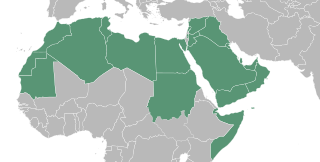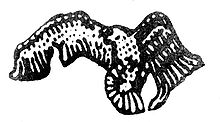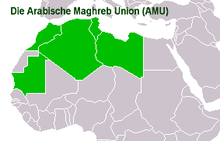Arab world

The term Arab world ( Arabic العالم العربي, DMG al-ʿālam al-ʿarabī ) denotes a region in North Africa and the Middle East . States with a predominantly Arab culture are considered part of the Arab world.
Despite its frequent use, the term is not precisely defined (therefore mostly lower case in Arabic ). Several criteria can be used to define membership of the Arab world: the dominance of the Arabic language (linguistic criterion), the influence of Islam (religious criterion) and finally membership in the Arab League (political criterion).
Geographical division of the Arab states
Africa
The North African states on the Atlantic and Mediterranean coasts, which were Arabized through the spread of Islam in the 7th and 8th centuries and still have more or less strong traditions of autochthonous peoples ( Berbers , Tuareg ):
-
 Mauritania
Mauritania
-
 Morocco
Morocco
-
 Algeria
Algeria
-
 Tunisia
Tunisia
-
 Libya
Libya
-
 Western Sahara (political status disputed since 1976)
Western Sahara (political status disputed since 1976)
The Nile states with an ancient agricultural tradition:
The countries in the Horn of Africa , which have had intensive connections to South Arabia since the earliest times:
-
 Somalia ( Somaliland has been effectively split off from Somalia since 1991 )
Somalia ( Somaliland has been effectively split off from Somalia since 1991 )
-
 Djibouti
Djibouti
-
 Comoros
Comoros
Asia
The states on the Arabian Sea or southern and central Arabia :
The states of the Levant and Northern Arabia :
Promenade Corniche Beirut
Linguistic criterion
According to the linguistic criterion, the Arab world corresponds to a group of 24 states from Mauritania in the west to the Sultanate of Oman in the east and 2 non-sovereign areas. The spread of Arabic is largely due to the history of the spread of Islam in the 7th century. However, the linguistic criterion is not sufficient to consider the Arab world. Some countries where parts of the population speak Arabic are still typically not considered part of the “Arab world”, including Israel, Somalia, Djibouti, Eritrea and Chad.
The following list shows 26 sovereign states and non-sovereign areas where the Arabic language is spoken. Countries with an Arab majority are highlighted in color. The United Arab Emirates are seen as part of the Arab world, although the Arabs are the minority there in the total population. For this reason, foreign, temporary residents are excluded from the table.
| country | capital city | Area (in km²) |
Inhabitants (in millions) |
Proportion of Arab ethnicity |
Share of Arabic speakers |
|---|---|---|---|---|---|
|
|
Cairo | 1,001,449 | 94.04 | 97% | k. A. |
|
|
Algiers | 2,381,741 | 31.84 | 98% | 98% |
|
|
Manama | 711 | 1.04 | approx. 51% | approx. 51% |
|
|
Djibouti | 23,200 | 0.51 | approx. 5% | k. A. |
|
|
Asmara | 121.144 | 5.02 | k. A. | k. A. |
|
|
Baghdad | 434.128 | 28.94 | 75-80% | 75-80% |
|
|
Tel Aviv or Jerusalem | 22,380 | 8.00 | 20.1% | k. A. |
|
|
Sana'a | 536.869 | 25.41 | 97% | 97% |
|
|
Amman | 89,342 | 6.34 | 99.2% | 99.2% |
|
|
Doha | 11.606 | 2.67 (of which approx. 0.3 million citizens) | 45% (100% of citizens) | 45% (100% of citizens) |
|
|
Moroni | 1,862 | 0.75 | k. A. | k. A. |
|
|
Kuwait | 17,818 | 2.75 | approx. 60% | approx. 60% |
|
|
Beirut | 10,452 | 4.52 | 95% | 95% |
|
|
Tripoli | 1,775,500 | 6.31 | 90% | 90% |
|
|
Rabat | 446,550 | 32.60 | 90% | 90% |
|
|
Nouakchott | 1,030,700 | 3.44 | approx. 70% | approx. 70% |
|
|
Muscat | 309,500 | 3.15 | k. A. | k. A. |
|
|
Gaza / Ramallah | approx. 6,300, excluding Zone C areas | 4.33 | approx. 83% | k. A. |
|
|
Riad | 2,240,000 | 27.01 | 90% | 90% |
|
|
Mogadishu | 637.657 | 13.18 | approx. 1% | approx. 13% |
|
|
Khartoum | 1,886,068 | 30.89 | approx. 70% | approx. 70% |
|
|
Damascus | 185.180 | 17.83 | k. A. | k. A. |
|
|
N'Djamena | 1,284,000 | 10.32 | 9% | 26% |
|
|
Tunis | 163,610 | 10.78 | 98% | 98% |
|
|
Abu Dhabi | 83,600 | 5.47 (of which less than 20% are citizens) |
70% (from citizens) | k. A. |
|
|
El Aaiún | 266,000 | 0.54 | over 98% Arabs or Arabized Berbers | k. A. |
Religious criterion
The term is related to the Islamic world . The Arabs are in the minority in the Islamic world, although Islam originates from Arabia and is handed down and preached in Arabic .
Arabism is defined independently of religious affiliation: Arabs can belong to any religious worldview or be atheists . In Lebanon , entire regions (such as the three administrative districts of Kesrouan, Metn and Jabal Lubnan (Mont Liban)) have a closed Arab-Christian population structure, up to the first half of the 20th century they even made up the majority of the population there.
The pan-Arabism is considered recruiting ground of Islamism , the ideology but other objectives than the nationalist pan-Arabism. In contrast to religiously legitimized Arab ideologies, Islamism negates the Christian element in the Arab world and its autochthonous character. For example, there was an above-average number of Arabs from Christian families active in the pan-Arab movement, alongside Michel Aflaq (Syrian founder of the Baath party ) and Elias Farah (Syrian-Iraqi Baath ideologist), for example, the SSNP founder Antun Saada , who was executed in Lebanon in 1949 In 2005, the Lebanese Communist Party Secretary General George Hawi and (Marxist) PLO leaders such as George Habasch murdered .
Political criterion

On the one hand, the term can refer to the entirety of the member states of the Arab League (and their inhabitants), and on the other hand, the contiguous settlement area of the Arabs or al-watan al-arabi /الوطن العربي/ al-waṭan al-ʿarabī / denote 'Arab fatherland'.
The two terms are not identical, as there are both Arab minorities in countries that are not members of the Arab League (such as Turkey and Iran or Israel) and member states that do not have a clear Arab majority, such as Somalia and Djibouti or the Comoros. The Arab Fatherland includes nationalists, but mostly also the Iranian province of Khuzestan , the Sanjak Alexandrette ( İskenderun ), the Western Sahara and Eritrea , although these areas do not belong to the League.
Politically, there is a common dream in the Arab world of an Arab nation united in one state. All previous attempts at unification by pan-Arabism have been unsuccessful. Well-known pan-Arab thought leaders and leaders of the modern age are Michel Aflaq , Gamal Abdel Nasser and Muammar al-Gaddafi , but the PLO also sees itself as the spearhead of the Arab unification movement in the thought that the Palestinian revolution could be the trigger for the Arab revolution . Not least because of this view, the Middle East conflict is not only formative for Israel , but also regularly moves the Arab masses .
The Arab League is an association of Arab states, was founded on March 22, 1945 in Cairo and consists of 22 member states.
Economic and social situation
Most of the Arab states are emerging or developing countries . Exceptions are Saudi Arabia , Kuwait , Qatar , Bahrain and the United Arab Emirates , which today are industrialized countries with, however, very little diversified industry structure because they remain heavily dependent on oil exports. The oil resources are also the reason for the geopolitical importance of the region, in which England used to be and, since the Iranian revolution, the USA has become more and more militarily involved. This dependence on oil is partly responsible for the delay in the development of a diversified industry structure (so-called resource curse ). Although there is a high proportion of small and micro-entrepreneurs, most of them are active in traditional business areas. The rate of start-ups (except in Qatar and Morocco ) is below the global average. Women are far below average in start-ups, which is changing only slowly. A predominantly patriarchal social structure hinders the participation of women in economic life. Large sovereign wealth funds like ADIA in Abu Dhabi dominate large areas of the economy and hinder private initiatives.
According to the World Bank , the economy in the countries of the Middle East grew by an average of 5.31 percent per year between 2000 and 2006. The gross national income of all 22 Arab League countries in 1999 was $ 631.2 billion. In 2006 the gross national product rose to 1.585.14 billion dollars. Saudi Arabia has the largest gross domestic product in the Arab world.
literature
- Alexander Flores: The Arab World. A small non-fiction dictionary. Reclam, Ditzingen, 2003. ISBN 978-3-15-018270-3 .
- Ulrich Haarmann : History of the Arab World. CH Beck, Munich 2004. ISBN 978-3-406-47486-6 .
- Khalid Al-Maaly : The Arab World. Between tradition and modernity. Palmyra, 2004. ISBN 978-3-930378-56-2 .
- Alfred Schlicht: History of the Arab World . Reclam-Verlag, Stuttgart 2013, ISBN 978-3-15-010916-8 .
- Udo Steinbach : The Arab World in the Twentieth Awakening - Upheaval - Perspectives. Kohlhammer, Stuttgart 2016, ISBN 978-3-17-032541-8 .
- Günter Barthel , Kristina Stock: Lexicon Arab World. Culture, way of life, economy, politics and nature in the Middle East and North Africa. Reichert, 1994. ISBN 978-3-88226-783-9 .
See also
- MENA region
- Islamic expansion
- Umma
- Arab striving for unity
- Arab League
- arab newspapers
- Arabic spring
Web links
Individual evidence
- ↑ Information on the languages used in Somalia. IN: Ethnologue.com . In: Ethnologue .
- ↑ For the causes, see e.g. B. GEM Country Report 2008 for Egypt ( Memento of July 25, 2014 in the Internet Archive ), p. IX.
- ↑ Women's Empowerment ( Memento of July 4, 2010 in the Internet Archive ) Activities of the UNDP, accessed on October 4, 2012
- ↑ Federal Ministry for Economic Cooperation , accessed on January 11, 2016








